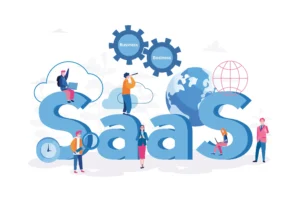As technology rapidly evolves, B2B SaaS platforms are no longer just operational tools — they’re strategic enablers that drive efficiency, scalability, and revenue. In 2025, enterprises are shifting from isolated systems to intelligent, interconnected ecosystems powered by automation, AI, and actionable insights.
If you’re in the SaaS space, especially offering ERP implementation, procurement automation, sales automation, or after-sales support, this is your moment. Enterprises are not just buying products; they’re investing in platforms that deliver outcomes.
Here’s a look at what modern enterprises truly expect from B2B SaaS providers in 2025.
🔁 1. From Tools to Platforms: Unified Automation is the Priority
Enterprises today want end-to-end automation — not disconnected tools. Whether it’s streamlining procurement cycles, digitizing sales operations, or managing post-sale services, businesses are choosing platforms that provide a single source of truth across departments.
💼 Our Take:
If you offer ERP solutions, emphasize how your platform connects procurement, sales, after-sales, and finance — removing silos and improving decision-making.
🔧 Example:
A company using separate systems for orders, inventory, and support may struggle with duplicate data and poor coordination. A single ERP with built-in procurement and sales automation can fix that with real-time sync.
🤖 2. AI-Powered Decision Support is the Norm
In 2025, enterprises expect every SaaS product to have a layer of artificial intelligence. Whether it’s identifying procurement anomalies, recommending the next best sales action, or predicting service breakdowns, AI is at the core of smart SaaS.
💡 Enterprise Demands:
-
Predictive analytics in sales performance
-
AI-powered procurement forecasts
-
Smart ticket routing in after-sales support
-
Automated workflow suggestions in ERP
🔧 Example:
In procurement, AI can automatically flag a price anomaly in a vendor quote. In sales, it can prioritize leads based on conversion likelihood. These features aren’t “nice-to-have” anymore — they’re expected.
📈 3. Sales Automation that’s Built for Speed and Accuracy
Modern sales teams are leaner, faster, and more field-driven. They need tools that automate repetitive tasks, ensure geo-based lead assignment, and offer real-time visibility into funnel movement and target achievements.
💼 What Sales Teams Want:
-
Mobile-first CRMs with visit tracking
-
Auto-lead assignment based on pin code or region
-
Integration with marketing and inventory modules
🔧 Your Advantage:
If you provide sales automation, highlight how your tool reduces lead-to-close time, automates follow-ups, and integrates seamlessly with ERP and support systems.
🛒 4. Procurement Automation is Moving Beyond Digitization
Enterprises are now looking at procurement as a strategic function, not just an operational one. Automation tools must manage vendor onboarding, approvals, quotations, PO cycles, and compliance tracking — all in one place.
💼 Enterprise Expectations:
-
Vendor scoring and performance dashboards
-
Approval workflows based on hierarchy
-
Integration with ERP and accounting tools
-
Real-time audit trails and compliance reporting
🔧 Use Case:
A centralized procurement system that auto-calculates L1 vendors, sends POs via workflow, and logs everything for audit simplifies the process and builds trust across finance and compliance teams.
🛠 5. After-Sales Support as a Revenue Driver
Support doesn’t end at product delivery — it starts there. Enterprises are now leveraging after-sales support platforms to drive retention, warranties, AMC tracking, and even up-sell opportunities.
💼 Features They Need:
-
Real-time service ticketing with escalation
-
Warranty lifecycle tracking and barcode tagging
-
Integration with sales and inventory for faster replacements
-
Field service scheduling and technician geo-tracking
🔧 Use Case:
For example, a company selling industrial machinery can reduce downtime and build brand loyalty by offering a support platform that automates service reminders and spare part ordering — all integrated into the ERP.
🧠 6. Custom ERP Implementations for Vertical-Specific Workflows
No two industries operate the same way. Enterprises expect customizable ERP systems that reflect their industry logic, approval hierarchies, and workflows — not generic, rigid templates.
💼 Key Expectations:
-
Modular design with plug-and-play features
-
Custom workflow builders
-
Role-based dashboards for each department
-
Integration with shipping, payment, and third-party systems
🔧 Pro Tip:
Showcase how your ERP implementations have helped clients in retail, manufacturing, logistics, or healthcare create smarter, connected operations with minimal disruption.
📊 7. Outcome-Driven Dashboards and Business Intelligence
What gets measured, gets managed. Modern enterprises don’t just want dashboards — they want actionable insights tied to KPIs, real-time alerts, and custom analytics that inform decisions across departments.
💼 Desired Features:
-
Spend vs budget analytics in procurement
-
Funnel and conversion insights in sales
-
SLA compliance and resolution times in support
-
Inventory and order health in ERP
🔧 Your Advantage:
If your platform enables clients to make real-time, data-backed decisions, make sure your blog, pitch decks, and demos highlight those results.
🔒 8. Security, Scalability & API-First Integrations
Whether you’re selling to mid-sized firms or large enterprises, your SaaS must be secure, scalable, and integration-ready. The more open and extensible your system is, the faster it can be adopted across verticals.
💼 Top Priorities:
-
ISO/GDPR compliance
-
SSO, MFA, and role-based access
-
Open APIs with pre-built connectors
-
Flexible hosting: SaaS, private cloud, on-premise options
✅ Final Thoughts
The 2025 enterprise buyer isn’t just looking for a product — they’re looking for a platform that delivers real value, solves critical problems, and grows with their business.
Whether it’s:
-
Accelerating operations through ERP Implementation
-
Streamlining sourcing with Procurement Automation
-
Increasing conversions via Sales Automation
-
Or building brand loyalty through After-Sales Support
— the winners in B2B SaaS will be those who combine deep domain knowledge, flexible technology, and measurable outcomes.
At Techstreet, we build SaaS products that work harder, think smarter, and grow faster.
Let’s build your next transformation together.
#B2BSaaS #SaaSTrends2025 #ERP #SalesAutomation #ProcurementTech #AfterSalesSupport #DigitalTransformation





